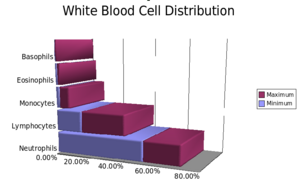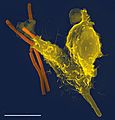White blood cell facts for kids
Quick facts for kids White blood cell |
|
|---|---|
 |
|
| A scanning electron microscope image of normal circulating human blood. In addition to the irregularly shaped leukocytes, both red blood cells and many small disc-shaped platelets are visible. | |
| System | Immune system |
White blood cells, also known as leukocytes, are special cells in your body. They are a key part of your immune system, which is like your body's defense team. Their main job is to protect you from germs that cause sickness and other things that don't belong in your body.
There are different types of white blood cells, but the main groups are granulocytes, lymphocytes, and monocytes. All white blood cells are made in your bone marrow, which is the soft center of your bones. You can find these cells all over your body, including in your blood and in your lymphatic system. Unlike other blood cells, all white blood cells have a nucleus, which is like the control center of the cell.
Contents
How White Blood Cells Protect You
White blood cells are super important for keeping you healthy. They are part of your body's amazing immune system. They help your body fight off infections and other diseases. When you get sick, it's often your white blood cells working hard to make you better!
The main types of white blood cells are:
- Granulocytes (like neutrophils, eosinophils, and basophils)
- Agranulocytes (like monocytes and lymphocytes, which include T cells and B cells)
Your bone marrow makes these cells. They are always ready to defend your body against germs and sickness. If you have a lot of white blood cells, it usually means your body is fighting an infection or inflammation. Sometimes, a very high count can point to other health issues, but that's less common.
Even though white blood cells make up only about 1% of your blood, they are incredibly powerful. They are much fewer than red blood cells, which make up about 40% to 45% of your blood. But that small 1% is vital for your immunity and overall health!
Different Kinds of White Blood Cells
There are several types of white blood cells, and each one has a special role in protecting your body. Let's learn about them!
Lymphocytes: The Smart Defenders
Lymphocytes are round white blood cells. They are a bit bigger than a red blood cell. They have a round center and not much cytoplasm (the jelly-like stuff inside a cell). These cells are part of your lymphatic system. They are like the "smart" defenders because they target specific germs or harmful substances using special tools called antibodies.
There are three main types of lymphocytes:
- B-cells: These cells make antibodies. Antibodies are like tiny flags that attach to viruses or bad cells. This tells other immune cells to find and destroy those marked invaders.
- T-cells: Some T-cells help B-cells make more antibodies. Other T-cells are like "killer" cells that destroy cells that have been infected by viruses or are cancerous.
- Natural Killer Cells (NK cells): These cells are part of your body's first line of defense. They kill cells that have been infected by a virus or are part of a tumor.
Monocytes: The Clean-Up Crew
Monocytes are like "reserve" cells. They can change into other important cells called macrophages and dendritic cells. These new cells work together in your body's tissues to fight disease. Monocytes have a kidney-bean shaped center and lots of cytoplasm. When they move through your tissues, they can change shape to eat germs, "junk" cells, and dead cells. They are like the clean-up crew!
Granulocytes: The Grainy Fighters
The next three types of white blood cells are called granulocytes. They get this name because they all have rough, grain-like particles inside them. These particles help them attack viruses and bacteria. Granulocytes are also called polymorphonuclear leukocytes because their nucleus (the cell's control center) has three segments, making it look like it has many shapes.
Neutrophils: The First Responders
Neutrophils are the most common type of white blood cell in mammals, making up about 70% of all leukocytes. They are a super important part of your immune system. When you get an injury, neutrophils rush to the site within minutes. They are a big part of what makes up pus. They have a short life, usually only a couple of days.
Their nucleus looks like a string of beads and doesn't pick up much stain. Like other phagocytes, they actually eat bacteria and dead cells. They also release special proteins that help damage and destroy bacteria.
Basophils: The Allergy Responders
Basophils are rare granulocytes. If you looked at 1000 white blood cells, you would only find 1 to 3 basophils! Their nucleus is hidden by granules that turn dark blue when stained. Basophils carry chemicals like histamine and heparin. They show up when your body is fighting certain parasites or having an allergic reaction. Scientists are still learning exactly how they work.
Eosinophils: The Parasite Fighters
Eosinophils are another type of white blood cell. They are part of your immune system that fights parasites and certain infections. Like mast cells and basophils, they also play a role in allergies and asthma. Eosinophils are round cells with a lobed nucleus. They have granules that turn red when stained. These granules are full of proteins that can be released to help destroy invaders.
Checking Your White Blood Cells
A test called a differential count can tell doctors how many white blood cells you have in your blood. It also shows how many of each specific type of white blood cell is present. This helps doctors understand if your body is fighting something or if there's another issue.
White Blood Cell Problems
Sometimes, white blood cells don't work quite right. This can happen in a few ways:
- Too many white blood cells: This is called Leukocytosis. It's usually a good sign that your body is fighting an infection. But sometimes, it can mean there's an issue with how your cells are growing.
- Too few white blood cells: This is called leukopenia. It means your body might have trouble fighting off infections.
There are also times when the number of white blood cells is normal, but the cells themselves don't work as they should. Serious problems with white blood cells can include certain types of cancer, like leukemia and lymphoma.
Images for kids
-
Neutrophil engulfing anthrax bacteria
See also
 In Spanish: Leucocito para niños
In Spanish: Leucocito para niños




